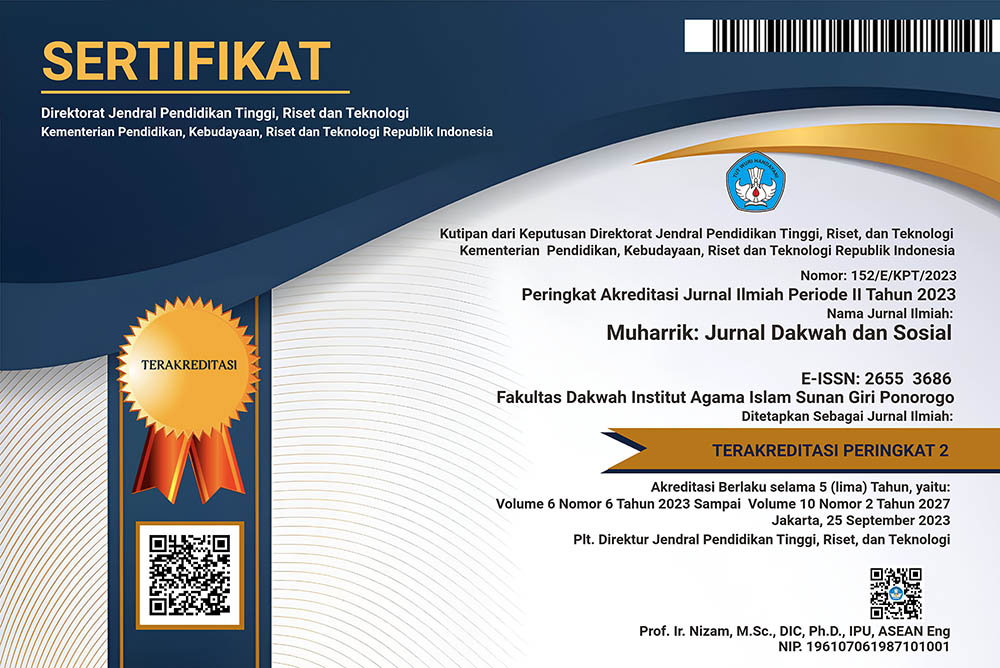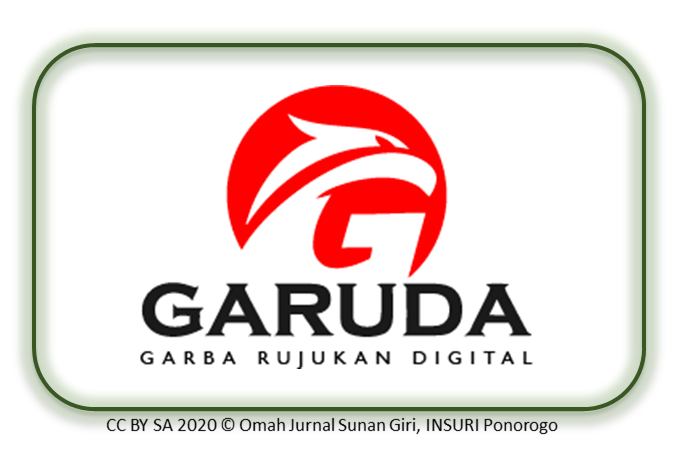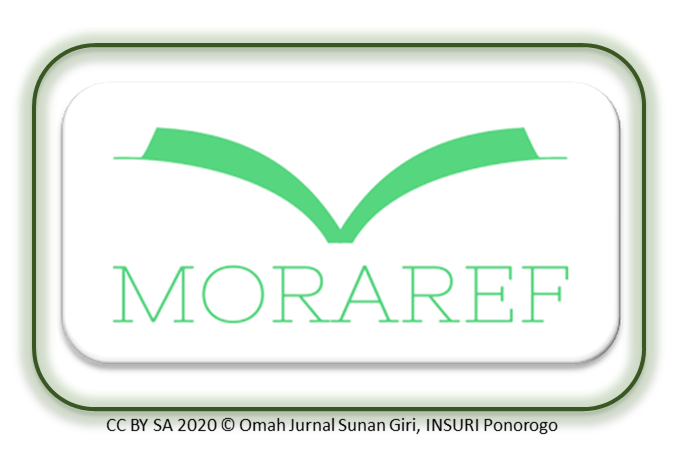Digital Preaching Rhetoric on Tiktok Media: Case Study of Habib Husein Ja’far Account
DOI:
https://doi.org/10.37680/muharrik.v8i1.7553Keywords:
Digital Preaching, Rhetoric, TikTok, Habib Husein Ja'farAbstract
This study analyzes the rhetorical strategies employed in digital da'wah through Habib Husein Ja'far's TikTok account, focusing on integrating Aristotle's rhetorical elements: Ēthos, Pathos, and Logos. Using a qualitative content analysis approach, the study examined ten selected TikTok videos uploaded between June and August 2024. The data were analyzed using a thematic coding framework that identified verbal, visual, and emotional cues corresponding to each rhetorical element. The findings reveal that Habib Husein Ja'far constructs ēthos through consistent use of culturally resonant fashion and informal yet authoritative speech. Pathos is activated through emotionally charged thumbnails, personal narratives, and audio-visual editing that appeals to viewers' feelings. Logos appears in simplified language, analogies, and occasional textual references to Islamic sources, enhancing message clarity and coherence. Notably, the most viral video, garnering over 10 million views, illustrates the effective convergence of these rhetorical elements in a short, relatable format. This study underscores the significance of rhetorical literacy in digital da'wah and demonstrates how TikTok can serve as a powerful platform for religious engagement. The results suggest that future da'wah practices can benefit from a balanced, theory-informed rhetorical approach that adapts to platform-specific audience dynamics while preserving the core values of Islamic communication.
Downloads
References
Abdurrahman, Q., & Badruzaman, D. (2023). TANTANGAN DAN PELUANG DAKWAH ISLAM DI ERA DIGITAL. KOMUNIKASIA: Journal of Islamic Communication and Broadcasting, 3(2). https://doi.org/10.32923/kpi.v3i2.3877
Adji, W. S., & Nurdin, A. (2018). Metodologi Dakwah Islam Di Zaman Milenial. International Seminar on “Dakwah, Local Wisdom and Transnational Islam, 27.
Agus, A. (2023). Reaching The Millennial Generation Through Da’wah On Social Media: Menjangkau Generasi Milenial Melalui Dakwah Di Media Sosial. Jurnal Da’wah: Risalah Merintis, Da’wah Melanjutkan, 6(2), 129–144.
Berger, J. (2016). Contagious: Why things catch on. Simon and Schuster.
Fadillah, M. I. R., Aang, R., & Yuningsih, Y. (2023). Retorika Gus Miftah Dalam Dakwah Pada Media Sosial Youtube. Tabligh: Jurnal Komunikasi Dan Penyiaran Islam, 8(1), 25–44.
Faridah, F., Zulkarnain, Z., Yusuf, M., & Asriadi, A. (2022). Efektivitas Dakwah Melalui Media Sosial Instagram Dalam Pandangan Kaum Milenial. RETORIKA: Jurnal Kajian Komunikasi Dan Penyiaran Islam, 4(2), 138–150.
Febriyani, S. A. A., Rizki, J. W. S., & Siregar, N. M. (2024). Media Sosial Instagram Sebagai Sarana Dakwah Di Kalangan Mahasiswa. Hikmah, 18(1), 147–162.
Firdaus, I. F., Arief, M., & Romadhan, M. I. (2023a). Retrorika Dakwah Habib Husain Jafar Dalam Konten Pemuda Tersesat. PROSIDING SEMINAR NASIONAL MAHASISWA KOMUNIKASI (SEMAKOM), 1(2, Juli), 546–553.
Firdaus, I. F., Arief, M., & Romadhan, M. I. (2023b). Retrorika Dakwah Habib Husain Jafar Dalam Konten Pemuda Tersesat. PROSIDING SEMINAR NASIONAL MAHASISWA KOMUNIKASI (SEMAKOM), 1(2, Juli), 546–553.
Furley, D. J., & Nehamas, A. (2015). Aristotle’s rhetoric: Philosophical essays. In Aristotle’s Rhetoric: Philosophical Essays. https://doi.org/10.1515/9781400872879
Higgins, C., & Walker, R. (2012). Ethos, logos, pathos: Strategies of persuasion in social/environmental reports. Accounting Forum, 36(3). https://doi.org/10.1016/j.accfor.2012.02.003
Maulidna, F., Ulfi, K., Mulia, A., Ramadhan, A. Z., & Saleh, M. (2025). Etika Dakwah di Media Digital: Tantangan dan Solusi. Jurnal Manajemen Dan Pendidikan Agama Islam, 3(2), 315–336.
Moreland, F. L., & Kennedy, G. A. (1980). Classical Rhetoric and Its Christian and Secular Tradition from Ancient to Modern Times. The Classical World, 73(6). https://doi.org/10.2307/4349226
Pridiastuti, A. (2022). Retorika dakwah ustadzah halimah alaydrus melalui media sosial youtube (analisis pada tema" rumah tangga” dalam channel ustadzah Halimah Alaydrus). Komunika: Journal of Communication Science and Islamic Dakwah, 6(2), 1–20.
Rokhman, S., & Muslimah, M. (2021). RETORIKA DAKWAH DR. ZAKIR NAIK DALAM MENDA’WAHKAN ISLAM KEPADA KAUM NASHRANI. Jurnal Da’wah: Risalah Merintis, Da’wah Melanjutkan, 4(01). https://doi.org/10.38214/jurnaldawahstidnatsir.v4i01.91
Samsudin, D., & Putri, I. M. (2023). Etika dan Strategi Komunikasi Dakwah Islam Berbasis Media Sosial di Indonesia. Ath-Thariq: Jurnal Dakwah Dan Komunikasi, 7(2). https://doi.org/10.32332/ath-thariq.v7i2.7474
Tritintya, N. P. D. E. (2024). Dramaturgi Presentasi Diri Ni Luh Djelantik Pada Media Sosial Instagram Jelang Pilkada 2024. Jurnal Penelitian Sosial Ilmu Komunikasi, 8(2), 94–103.
Umi, K. (2023). Pentingnya Keterampilan Retorika Da’i di Era Society 5.0 dalam Efektivitas Keberhasilan Dakwah Kepada Mad’u. Al-Manaj: Jurnal Program Studi Manajemen Dakwah, 3(02), 38–44.
Ummah, N. H. (2023). Pemanfaatan sosial media dalam meningkatkan efektivitas dakwah di era digital. Jurnal Manajemen Dakwah, 11(1).
Warnick, B. (2007). Rhetoric online: Persuasion and politics on the World Wide Web (Vol. 12). Peter Lang.
Yanto, Y. (2025). Pesan Kampanye Dan Efektivitas Retorika Politik. Professional: Jurnal Komunikasi Dan Administrasi Publik, 12(1), 169–174.
Downloads
Published
How to Cite
Issue
Section
License
Copyright (c) 2025 Naufal Muhazzib, Twediana Budi Hapsari

This work is licensed under a Creative Commons Attribution-NonCommercial 4.0 International License.
The author(s) retain/s the copyright and grant/s Muharrik: Jurnal Dakwah dan Sosial the first publication rights licensed under the Creative Commons Attribution-NonCommercial 4.0 International (CC BY-NC 4.0) , which allows others to access (search, read, download and quote), share (copy and redistribute the material in any media or format) and adapt (mix, modify and develop) works for legitimate non-commercial purposes, with recognition of the authorship of the work and its initial publication in this journal.












